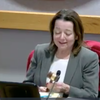First solar farm may come to Guilderland
— Photo from Google Earth
Planning board Chairman Stephen Feeney estimates the amount of cleared land on the property at 2825 Curry Rd. to be about 20 acres. Owner Vetto Vaitulis is applying for a change in zoning district that would allow him to install a solar farm on a portion of his 47.9-acre property. The planning board has asked him to submit a sketch plan showing how much space the solar arrays would take up, where they would be located, and what structures would be built.
GUILDERLAND — Town officials are considering a proposal for what would be Guilderland’s first large-scale solar farm.
Applicant Vetto Vaitulis owns the 47.9-acre property at 2825 Curry Rd. that lies between Hembold Drive and Prout Lane.
Solar arrays would be placed on about 20 acres of already-cleared land on the property.
The property is “very well buffered” and solar arrays should not have any visual impact on neighbors, said attorney Andrew F. Brick of Donald Zee, P. C., representing Vaitulis before the planning board on March 8. A satellite photo on Google Earth shows the edges of the property to be wooded, although the area with the least vegetation is along Curry Road itself.
Vaitulis told The Enterprise last week that the project was like a traditional farm. “The only difference,” he said, “is I’m growing sunshine.” He added that traditional farms are limited to a three- or four-month growing season, but that a solar farm is productive throughout the year.
Vaitulis would continue to live in the single-family home located on the property.
Planning board Chairman Stephen Feeney asked if the solar arrays would be placed only on the large area at the center of the property that is already cleared of trees. Brick said that he believed so.
Vaitulis said that this land was cleared decades ago. He said that he has a back and a front field; the back field is about 20 acres and the front about seven. A strip of woods that currently separates the two fields could easily be removed, he said.
The town’s zoning and land-use law says that existing on-site vegetation should be preserved as much as possible and that forested sites are not to be deforested to allow for construction of solar farms. It also says that solar arrays should not cover more than 60 percent of a property.
Feeney asked the applicant to produce a sketch plan that would show the size and location of the proposed array, including any electrical components, poles, or fences. Feeney said that he thought the only fences in a solar farm need to be placed around potentially hazardous components, and not around the arrays themselves.
In response to a question, Brick said that he thought the project would involve tying into the electrical poles on the street.
Brick was not sure just how large the cleared area was. Feeney estimated it at about 20 acres.
Feeney suggested that the applicant consider applying for F-5 zoning rather than agricultural, “to limit the potential for development in the future.” This zoning district has a minimum of five-acre lots, while an agricultural district allows for two-acre lots.
The planning board will recommend to the town board that a conditional restriction be placed on the deed, that mining not be allowed. Mining is permitted as a special use in all agricultural districts, whether A, RA-5, or RA-3.
Brick told the board that Vaitullis plans, eventually, to bequeath the land to charitable organizations.
Asked if he had spoken with Vaitulis about the possibility of selling it to the Pine Bush and taking out a life estate or subdividing out a parcel for the house, Brick told Feeney that he had not, but that he would.
Christopher Hawver, the executive director of the Albany Pine Bush Preserve Commission, told The Enterprise that the Pine Bush is looking for more land, and that the land at 2825 Curry Rd. is recommended for full protection. He said that the Pine Bush currently manages 3,300 acres and hopes to continue to raise that number to 5,400 acres and to “fill in that jigsaw puzzle” and “build contiguity, not just for species movement but also for recreational purposes like trails.”
The Pine Bush currently has some lands that are across the street from the Vaitulis property, Hawver said.
Asked about the idea of selling to the Pine Bush, Vaitulis told The Enterprise that he preferred to leave the land to a charitable organization such as St. Jude Children’s Research Hospital, “where it can do some good,” rather than sell or donate it for “somebody to just walk through and look at birds.”
Vaitulis said he expected that, if the charitable organizations did not want the land, they could sell it and benefit from the proceeds.
Referring to solar farms, Vaitulis said, “It’s probably the only business where there won’t be any in-and-out traffic. Like a cemetery, except with no one coming to bring flowers.”
A solar farm was proposed in Guilderland last fall for property on Route 156, next to the former Peter Young Center, near the border with Altamont. But U. S. Solar Solutions withdrew its proposal after neighbors expressed opposition and the Altamont village board voted unanimously to recommend that the Guilderland Zoning Board of Appeals disapprove the project.
A law empowers Altamont to make recommendations about projects on its periphery. The village’s recommendation against the project would have meant that the measure could only pass the town board with a supermajority.
U. S. Solar Solutions then went ahead with a proposal it had originally intended to be part of a two-solar farm idea. That proposal is near the rejected one, a little further up Route 156, on land owned by the Peter Young Center that is located not in Guilderland but in Knox, which currently has several solar-farm proposals in the works.



